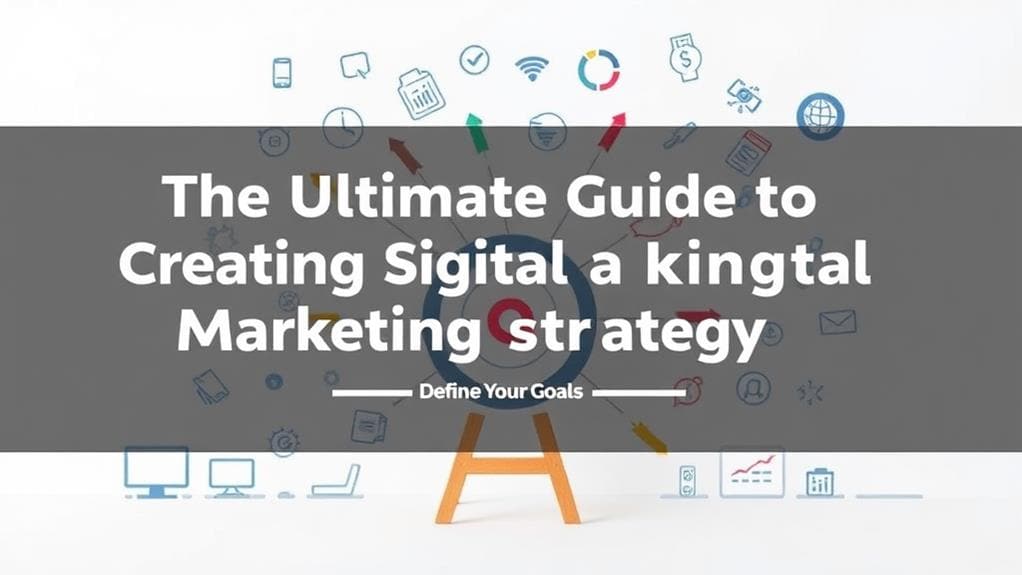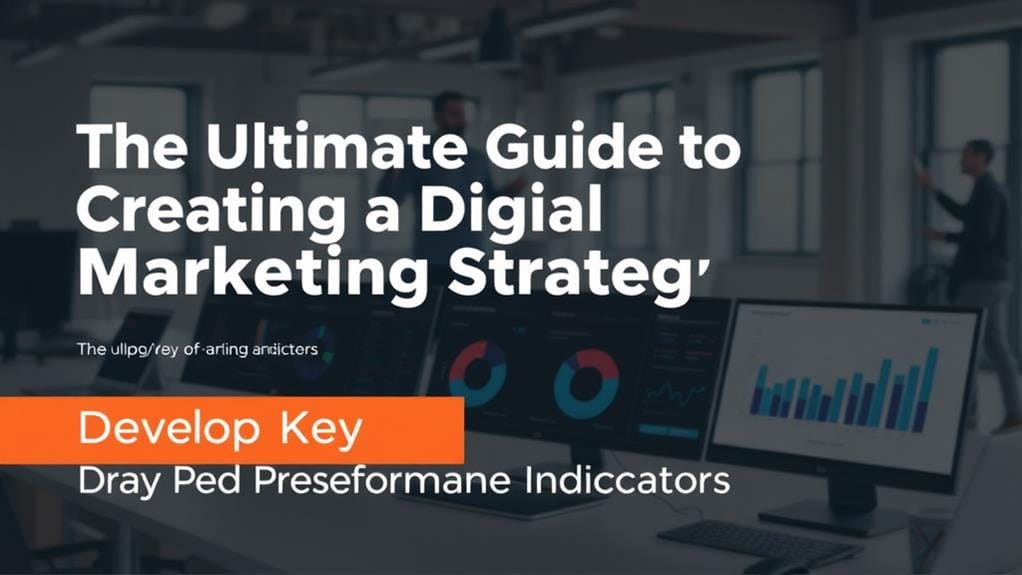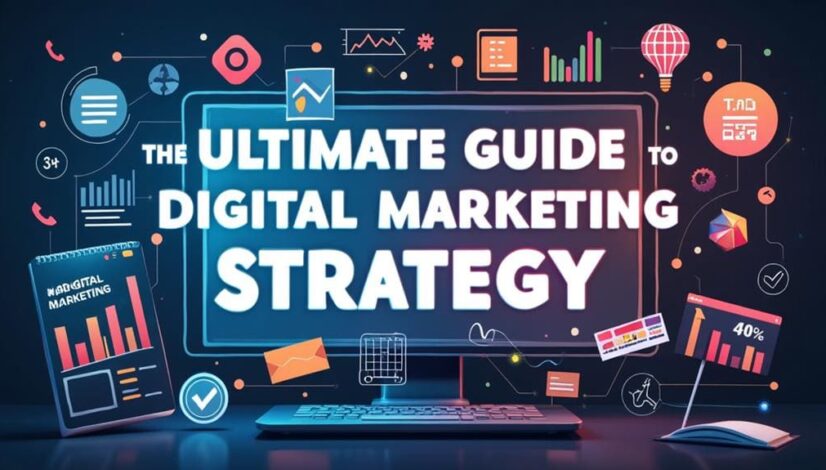The Ultimate Guide to Creating a Digital Marketing Strategy
Creating a robust digital marketing strategy begins with clearly defining your goals using SMART criteria. Next, it's essential to identify your target audience through demographic and psychographic analysis, allowing for tailored messaging. Evaluate your competition to identify market gaps and opportunities. Selecting the right digital channels—be it social media, email, or PPC—will maximize engagement. Establish key performance indicators to measure success and employ SEO best practices to enhance visibility. By monitoring and adjusting your strategy based on data insights, you guarantee sustained growth. Explore further to uncover the insights necessary for a transformative approach to digital marketing.
Key Takeaways
- Define clear, SMART goals to guide your digital marketing strategy and align resource allocation effectively.
- Understand your target audience through demographic and psychographic analysis for tailored messaging and engagement.
- Conduct competitor analysis to identify your strengths, weaknesses, and market opportunities for strategic advantage.
- Choose appropriate digital marketing channels, like social media and email, to maximize engagement and brand reach.
- Establish measurable KPIs to evaluate performance and ensure alignment with business goals for continuous improvement.
Define Your Goals

In the field of digital marketing, understanding one's objectives is essential; many organizations often overlook this critical step. Defining clear goals is not merely a formality, but a strategic necessity that affects every layer of digital marketing initiatives. Implementing SMART objectives—specific, measurable, achievable, relevant, and time-bound—anchors your efforts and guarantees a long-term vision that resonates with your brand's core identity.
Effective resource allocation hinges on well-defined goals that guide decision-making. For instance, aligning your marketing budget considerations with your established objectives allows for ideal technology integration and efficient expenditure management. Through this thoughtful approach, you can prioritize expenditures that yield significant returns, while avoiding financial pitfalls through diligent risk assessment.
Moreover, engaging stakeholders in the goal-setting process fosters a culture of team collaboration, guaranteeing that every department is aligned with the overarching objectives. By incorporating performance benchmarks, you create a roadmap that facilitates progress tracking and makes it easier to adapt to market trends as they arise.
Building a dynamic strategy requires a thorough understanding of how goals intertwine with technology and data analytics. This converging knowledge equips organizations to pivot swiftly in response to challenges and opportunities alike.
In essence, defining your goals establishes a clear pathway towards achieving freedom from uncertainty in your digital marketing efforts, empowering both your teams and your organization to innovate and adapt in an ever-evolving landscape.
Identify Your Target Audience
Understanding your target audience is essential for effective digital marketing, as it allows for tailored messaging that resonates with potential customers.
Employing demographic analysis techniques can uncover crucial characteristics such as age, gender, and location, while exploring behavioral insights reveals patterns in how these individuals engage with your brand.
Together, these methods enhance strategic decision-making and optimize marketing efforts for greater impact.
Demographic Analysis Techniques
Identifying your target audience is essential for crafting a successful digital marketing strategy, as it enables businesses to tailor their messaging and campaigns to specific consumer segments.
Employing effective data segmentation methods is crucial, allowing marketers to dissect large pools of data into actionable insights. By utilizing audience profiling techniques, businesses can build accurate customer personas that reflect their ideal consumers' characteristics, motivations, and behaviors.
Utilizing market research tools facilitates understanding demographic trends analysis, which in turn informs specific campaign strategies.
Psychographic analysis strategies explore deeper than demographics, revealing consumer attitudes and lifestyle choices that influence purchasing decisions.
Geographic targeting approaches help marketers focus their efforts on regions where their target audience is concentrated, optimizing resource allocation for higher returns.
Behavioral Insights Exploration
Analyzing consumer behavior provides valuable insights that can enhance targeted marketing efforts. By leveraging data analytics, businesses can dissect purchase patterns and user engagement levels, leading to a deeper understanding of online habits.
Such insights enable brands to identify the nuances of decision making, ensuring that their marketing strategies resonate deeply with their audiences.
Utilizing sentiment analysis, marketers can gauge emotional responses to products or services, refining their approaches accordingly.
Behavioral segmentation further breaks down the audience into distinct groups, allowing for personalized marketing that speaks to each segment's unique preferences and needs.
For instance, understanding conversion triggers can dramatically boost user experience, driving customers to complete their desired actions more efficiently.
Analyze Your Competition

In today's competitive landscape, conducting a thorough analysis of your competitors is essential for developing an effective digital marketing strategy. By understanding the market positioning of your rivals, you can identify both the strengths and weaknesses they possess, allowing you to carve out your niche more effectively. This strengths analysis can reveal the unique advantages your competitors leverage, which may include superior product features, pricing strategies, or customer engagement practices.
Conversely, weaknesses identification is equally important. Evaluating the gaps in their offerings or customer service can highlight areas where you can outperform them. Opportunities assessment involves foreseeing trends or unmet needs in the market that you can capitalize upon, while threats evaluation focuses on potential challenges posed by competitors. This multifaceted approach will give you a well-rounded perspective on your competitive landscape.
Implementing benchmarking strategies against your competitors can streamline this process. By analyzing competitor tactics, such as their digital advertising initiatives, social media presence, and SEO strategies, you can determine how effectively they capture market share. This knowledge enables you to formulate differentiation strategies, setting your brand apart in meaningful ways.
As you synthesize this information, consider how you can leverage your unique strengths and address market demands, ultimately positioning your brand to thrive in a crowded marketplace. Understanding these components not only empowers your digital marketing strategy but also enhances your overall business resilience.
Choose Digital Marketing Channels
Selecting the right digital marketing channels is essential for maximizing your brand's reach and engagement.
By leveraging social media platforms, email marketing strategies, and pay-per-click advertising, businesses can create a multi-faceted approach that targets specific audience segments effectively.
Each channel offers unique advantages and insights that, when combined thoughtfully, can drive measurable results and enhance overall marketing performance.
Social Media Platforms
Maneuvering the vast landscape of social media platforms requires a strategic approach tailored to your target audience and business objectives. Understanding social media trends and the unique algorithms that govern each platform is essential for optimizing reach and engagement.
Successful brands often leverage influencer partnerships to amplify their messages, harnessing authenticity and trust to captivate their audiences.
A well-structured content calendar plays a pivotal role in consistent posting, thereby enhancing audience engagement. Each piece of content should embody effective brand storytelling, connecting emotionally with viewers and encouraging shares.
Social listening tools are invaluable for understanding audience sentiments and adapting your strategy in real-time.
Utilizing platform analytics allows brands to assess performance, refine their strategies, and identify which ad formats yield the best results.
Community building is a powerful tactic, fostering loyalty and transforming customers into advocates.
Email Marketing Strategies
Email marketing strategies are pivotal for driving engagement and nurturing customer relationships in today's digital landscape.
To harness the full potential of email marketing, brands should consider the following key strategies:
- Email Segmentation Techniques: Tailoring content to specific audience segments helps increase relevance. Use demographic data, purchase history, and engagement metrics to group subscribers effectively.
- Automated Campaigns: Implement automated workflows to enhance efficiency and deliver timely messages. Automation enables personalized communication, such as welcome series or re-engagement campaigns, ensuring subscribers receive the right message at the right time.
- A/B Testing: Experimenting with different subject lines, messaging, and layouts allows marketers to identify what resonates best with their audience, leading to optimized open and click-through rates.
Pay-Per-Click Advertising
A strategic investment in pay-per-click (PPC) advertising can yield substantial returns, making it an imperative component of an all-encompassing digital marketing strategy. By leveraging precise keyword research, businesses can identify high-intent search terms that align with their target audience's needs.
Effective ad copywriting serves to capture attention and encourage clicks, while innovative bidding strategies optimize ad placement without exceeding budgetary constraints.
To maximize the effectiveness of PPC campaigns, it's essential to create compelling landing pages that deliver a seamless user experience. Audience segmentation allows for tailored messaging, ensuring that ads reach specific demographic clusters most likely to convert.
Remarketing techniques enable you to re-engage users who have previously interacted with your offerings, enhancing the chance of conversion.
Implementing conversion tracking is critical for measuring campaign success, providing insights into user behavior and ROI. A/B testing empowers marketers to refine ad elements, leading to better performance.
Utilizing ad extensions can further enrich ad visibility and engagement. Ultimately, continuous campaign optimization, informed by data-driven insights, is key to sustaining effective PPC advertising that fuels success while granting the freedom to explore innovative marketing avenues.
Develop Key Performance Indicators

In the domain of digital marketing, establishing clear and measurable Key Performance Indicators (KPIs) is critical for evaluating the effectiveness of strategies and campaigns. By creating performance benchmarks that align with your business goals, you empower your team to track progress and pivot when necessary.
An insightful digital marketing strategy embraces the essence of metric tracking, providing a roadmap for success while embodying the freedom to innovate.
To develop truly effective KPIs, consider focusing on these three essential components:
- Relevance: Confirm the KPIs are aligned with your specific objectives. Whether your goal is to increase brand awareness, generate leads, or drive sales, relevant metrics will provide invaluable insights.
- Measurability: KPIs should be quantifiable, allowing for objective analysis over time. Metrics such as conversion rates, customer acquisition costs, and return on ad spend can give you clear indicators of success or areas needing improvement.
- Timeliness: Establish a timeframe for evaluation. Regularly scheduled reviews allow you to monitor performance and make adjustments dynamically, confirming that your strategy remains aligned with market trends and consumer behavior.
With these principles in mind, you can create robust KPIs that not only motivate your team but also foster a culture of accountability and continuous improvement.
In a world where digital landscapes are ever-changing, maintaining a focus on precise, data-driven metrics will ultimately provide the freedom to adapt and thrive.
Create Engaging Content
To create engaging content, a thorough understanding of your audience is imperative, as it allows marketers to tailor messages that resonate on a personal level.
Additionally, incorporating visual elements can enhance retention and stimulate interest, given that studies show people process visuals 60,000 times faster than text alone.
Understand Your Audience
Understanding your audience is foundational to creating engaging content that resonates and drives action. By grasping diverse preferences and behaviors, marketers can connect meaningfully with their target demographic.
To achieve this, it is essential to implement the following practices:
- Audience Segmentation: Break your audience into distinct groups to tailor messaging that speaks to their unique needs and desires.
- User Personas: Develop detailed profiles that encapsulate user motivations, challenges, and aspirations, helping to shape content that aligns with their journeys.
- Feedback Loops: Establish channels for continuous feedback to refine understanding and adapt to evolving content preferences and communication styles.
In today's landscape, staying aware of demographic shifts is vital. Analyzing engagement metrics provides invaluable insights into how content performs across varying segments.
By adopting an insight-driven approach, brands can effectively navigate audience journeys, creating content that is not just engaging, but transformative.
Ultimately, this understanding fosters empowerment, allowing audiences to see themselves reflected in the narrative, igniting deeper connections and encouraging action toward brand objectives.
Utilize Visual Elements
Visual elements play an essential role in enhancing content engagement and retention, compelling audiences to absorb messages more effectively. Implementing visual storytelling techniques allows brands to create compelling narratives that resonate emotionally with their audience.
Infographic design is another critical component; it transforms complex data into digestible visuals, enhancing data visualization and facilitating immediate understanding.
Interactive content additionally engages users, fostering active participation and encouraging a deeper connection with your brand. By prioritizing branding consistency across visual formats, companies can strengthen recognition and trust.
In addition, color psychology plays a pivotal role in influencing perceptions; the right palette can evoke desired emotions and guide user experience.
Utilizing visual hierarchy guarantees that the most important elements capture attention first, improving information delivery. Alongside effective imagery usage, multimedia integration—including videos and animations—can further enrich the content, appealing to diverse learning preferences.
By skillfully combining these elements, brands can create an immersive experience that not only informs but inspires freedom, creativity, and exploration.
Ultimately, the strategic use of visual elements is essential for standing out in a crowded digital marketplace while fostering lasting relationships with your audience.
Implement SEO Best Practices

Implementing SEO best practices is vital for enhancing your online visibility and driving organic traffic to your website. To achieve this, consider the following important elements:
1. Keyword Research: Identifying the right keywords is the cornerstone of effective SEO. Use tools like Google Keyword Planner to discover phrases that your target audience actively searches for.
2. On-Page Optimization: Optimize individual pages for search engines while enhancing the user experience. This involves integrating keywords naturally into titles, headings, and content.
Additionally, make sure images are optimized and page load times minimized for improved engagement and mobile optimization.
3. Backlink Strategy: Cultivating high-quality backlinks is integral to improving domain authority. Crafting valuable content that attracts links from reputable websites will enhance your credibility in the eyes of search engines.
Incorporating technical SEO elements, such as schema markup and optimizing for voice search, can further elevate your website's performance.
Additionally, SEO auditing helps to identify areas needing improvement, making certain that your strategies remain effective and compliant with search engine guidelines.
Local SEO practices should not be overlooked; optimizing your Google My Business listing can greatly affect local visibility.
Finally, content optimization focused on user experience can lead to higher engagement, lower bounce rates, and increased conversions.
Leverage Social Media Effectively
Effectively leveraging social media is essential for brands seeking to enhance engagement and expand their reach in today's digital landscape. A strategic approach begins with the creation of extensive content calendars tailored to align with social media trends and brand storytelling goals. By organizing posts in advance, brands can guarantee consistent engagement that resonates with their audience.
Influencer partnerships are instrumental in amplifying reach, as these collaborations can harness their followers' trust and advocacy, leading to authentic audience engagement. Additionally, incorporating user-generated content fosters a sense of community building, inviting customers to participate in the narrative and strengthen their bond with the brand.
Understanding platform algorithms is vital for optimizing content visibility. Each platform has unique characteristics; thus, cross-platform promotion enhances synergy and broadens exposure. Brands should adapt content format and messaging to maximize engagement across diverse platforms, ensuring resonance with varied audience segments.
Crisis management strategies must also be part of the social media strategy. In a time when information spreads rapidly, brands must be prepared to address negative feedback proactively, turning crises into opportunities for strengthening trust and transparency.
Ultimately, applying these techniques allows brands to harness the full potential of social media, creating a dynamic dialogue with audiences. Brands that prioritize thoughtful engagement not only build loyal communities but also pave the path for sustained growth in the fast-evolving digital arena.
Monitor and Adjust Strategies

To maximize the benefits of a well-crafted social media strategy, continual monitoring and adjustment of tactics are imperative. A dynamic approach empowers marketers to respond to the evolving digital landscape and consumer preferences. By harnessing real-time data and analytics, brands can implement data-driven adjustments that lead to continuous improvement in their marketing efforts.
Consider focusing on these key areas:
- Audience Engagement Metrics: Track likes, shares, comments, and saved posts to gauge audience interaction.
- Content Performance: Analyze which types of content (videos, articles, infographics) resonate most with your audience, and adjust your content strategy accordingly.
- Ad Campaign Effectiveness: Regularly review ad performance metrics to optimize targeting and messaging for maximum ROI.
The world of digital marketing shifts rapidly, and what works today may not sustain its effectiveness tomorrow. By committing to an iterative process where performance is regularly assessed, brands can address areas of weakness while amplifying successful strategies.
This proactive mindset not only fosters a culture of continuous improvement but also provides the freedom to pivot, innovate, and resonate authentically with audiences.
Incorporating tools such as social media dashboards and analytic software can streamline monitoring efforts, transforming insights into actionable strategies.
With a commitment to adapting and evolving, marketers can cultivate not only strategic resilience but also a vibrant connection with their audience, ensuring that their social media presence remains impactful and relevant.
Evaluate Your Results
Evaluating the results of your digital marketing strategies is essential for understanding their overall effectiveness and impact. This critical phase involves a thorough examination of performance metrics to decipher what worked, what didn't, and why. By leveraging data interpretation, marketers can transform raw numbers into actionable insights, influencing future campaign approaches and ensuring alignment with overarching business objectives.
Start by focusing on key performance indicators (KPIs) relevant to your goals, such as conversion rates, click-through rates, and customer acquisition costs. Analyzing these metrics provides an extensive view of where your strategy excels and where it falters. For instance, if your content marketing efforts yield high traffic but low engagement, it may signal a disconnect between audience interests and content offerings.
Moreover, segmenting data can reveal deeper insights. Comparing performance across different demographics, platforms, or campaign types can unearth specific trends that may otherwise go unnoticed. This granular data interpretation allows for a nuanced understanding of your audience, fostering a sense of freedom in decision-making. By clearly understanding your audience's preferences, you can craft campaigns that resonate more deeply, ultimately enhancing response rates and overall satisfaction.
Lastly, consider employing A/B testing to refine your strategies continually. Testing different approaches enables real-time adjustments based on data findings, paving the way for an adaptive digital marketing framework. Evaluating results isn't a one-time task; it's an ongoing commitment to growth that empowers your brand's journey in the dynamic digital landscape.
Frequently Asked Questions
How Often Should I Update My Digital Marketing Strategy?
To maintain an effective digital marketing strategy, updates should be conducted at least quarterly.
This allows for timely strategy evaluation based on performance metrics, enabling swift adaptations to market changes or emerging trends.
Additionally, monitoring competitor activities and shifts in consumer behavior should prompt adjustments.
What Budget Should I Allocate for Digital Marketing?
Research indicates that businesses allocate, on average, 6-10% of their total revenue to digital marketing.
Effective budget allocation is essential, as investing wisely can greatly enhance marketing ROI. Companies should evaluate their specific goals, target audience, and competitive landscape to determine the appropriate budget.
How Do I Stay Current With Digital Marketing Trends?
Staying current with digital marketing trends requires a multifaceted approach.
Regularly engage with industry reports and case studies that highlight shifts in social media algorithms and content marketing strategies. Emphasize influencer partnerships, leveraging their insights to connect with your audience.
Utilize audience segmentation data to refine your messaging and guarantee relevance.
Furthermore, attending webinars and networking events fosters creative ideas and allows for the exchange of innovative tactics with like-minded professionals.
Can I Automate My Digital Marketing Efforts?
Yes, automating your digital marketing efforts is not only feasible but also advantageous.
Implementing automated workflows can streamline repetitive tasks, allowing you to focus on strategic initiatives.
Furthermore, leveraging marketing analytics can provide insights into consumer behavior and campaign performance, enabling data-driven decisions.
This automation fosters efficiency while granting marketers the freedom to enhance creativity and innovation in their strategies, ultimately leading to more impactful outcomes and improved resource allocation.
What Tools Are Best for Managing Digital Marketing Campaigns?
To effectively manage digital marketing campaigns, leveraging tools that facilitate campaign management and performance analytics is essential.
Platforms like HubSpot, Marketo, and Hootsuite offer robust functionalities that streamline campaign execution while providing insightful data analytics.
These tools enable marketers to optimize strategies through real-time performance monitoring, ensuring that resources are utilized efficiently.
Adopting such solutions empowers businesses to enhance their marketing effectiveness, ultimately driving better engagement and achieving desired outcomes with greater freedom and flexibility.
Conclusion
To sum up, the development of a robust digital marketing strategy is not merely an application of marketing principles but rather a dynamic, iterative process that responds to an ever-evolving digital landscape. By systematically defining goals, understanding audience nuances, and employing rigorous data analysis, organizations can achieve sustained engagement and competitive advantage. Ultimately, the effectiveness of a digital marketing strategy lies not in its preliminary design but in its adaptability to emerging trends and consumer behaviors shaped by technological advancements.




